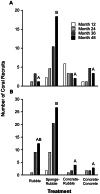Harnessing natural recovery processes to improve restoration outcomes: an experimental assessment of sponge-mediated coral reef restoration
- PMID: 23750219
- PMCID: PMC3672152
- DOI: 10.1371/journal.pone.0064945
Harnessing natural recovery processes to improve restoration outcomes: an experimental assessment of sponge-mediated coral reef restoration
Abstract
Background: Restoration is increasingly implemented to reestablish habitat structure and function following physical anthropogenic disturbance, but scientific knowledge of effectiveness of methods lags behind demand for guidelines. On coral reefs, recovery is largely dependent on coral reestablishment, and substratum stability is critical to the survival of coral fragments and recruits. Concrete is often used to immobilize rubble, but its ecological performance has not been rigorously evaluated, and restoration has generally fallen short of returning degraded habitat to pre-disturbance conditions. Fragments of erect branching sponges mediate reef recovery by facilitating rubble consolidation, yet such natural processes have been largely overlooked in restoring reefs.
Methods: On two reefs in Curacao, four treatments - coral rubble alone, rubble seeded with sponge fragments, rubble bound by concrete, and concrete "rubble" bound by concrete - were monitored over four years to investigate rubble consolidation with and without sponges and the ecological performance of treatments in terms of the number and diversity of coral recruits. Species specific rates of sponge fragment attachment to rubble, donor sponge growth and tissue replacement, and fragment survival inside rubble piles were also investigated to evaluate sponge species performance and determine rates for sustainably harvesting tissue. FINDINGS/SIGNIFICANCE: Rubble piles seeded with sponges retained height and shape to a significantly greater degree, lost fewer replicates to water motion, and were significantly more likely to be consolidated over time than rubble alone. Significantly more corals recruited to sponge-seeded rubble than to all other treatments. Coral diversity was also greatest for rubble with sponges and it was the only treatment to which framework building corals recruited. Differences in overall sponge species performance suggest species selection is important to consider. Employing organisms that jump start successional pathways and facilitate recovery can significantly improve restoration outcomes; however, best practices require techniques be tailored to each system.
Conflict of interest statement
Figures







References
-
- Connell JH (1978) Diversity in tropical rainforests and coral reefs. Science 199: 1302–1310. - PubMed
-
- Moberg F, Folke C (1999) Ecological goods and services of coral reef ecosystems. Ecol Econ 29: 215–233.
-
- Hughes TP, Baird AH, Bellwood DR, Card M, Connolly SR, et al. (2003) Climate change, human impacts, and the resilience of coral reefs. Science 301: 929–933. - PubMed
-
- Hughes TP (1994) Catastrophes, phase shifts, and a large-scale degradation of a Caribbean coral reef. Science 265: 1547–1551. - PubMed
-
- Gardner TA, Cote IM, Gill JA, Grant A, Watkinson AR (2003) Long-term region-wide declines in Caribbean corals. Science 301: 958–960. - PubMed
Publication types
MeSH terms
LinkOut - more resources
Full Text Sources
Other Literature Sources

